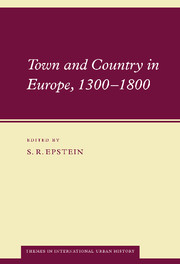Book contents
- Frontmatter
- Contents
- List of figures
- List of tables
- Notes on the contributors
- 1 Introduction. Town and country in Europe, 1300–1800
- 2 Town and country in Sweden, 1450–1650
- 3 Town and country in Holland, 1300–1550
- 4 Town and country in the Dutch Republic, 1550–1800
- 5 Town and country in England, 1300–1570
- 6 Town and country in England, 1570–1750
- 7 Town and country in the Polish Commonwealth, 1350–1650
- 8 Town and country in the Austrian and Czech lands, 1450–1800
- 9 Town and country in Germany, 1350–1600
- 10 Town and country in Switzerland, 1450–1750
- 11 Town and country in France, 1550–1750
- 12 Town and country in Castile, 1400–1650
- 13 Town and country in central and northern Italy, 1400–1800
- 14 Town and country in the kingdom of Naples, 1500–1800
- Index
11 - Town and country in France, 1550–1750
Published online by Cambridge University Press: 09 November 2009
- Frontmatter
- Contents
- List of figures
- List of tables
- Notes on the contributors
- 1 Introduction. Town and country in Europe, 1300–1800
- 2 Town and country in Sweden, 1450–1650
- 3 Town and country in Holland, 1300–1550
- 4 Town and country in the Dutch Republic, 1550–1800
- 5 Town and country in England, 1300–1570
- 6 Town and country in England, 1570–1750
- 7 Town and country in the Polish Commonwealth, 1350–1650
- 8 Town and country in the Austrian and Czech lands, 1450–1800
- 9 Town and country in Germany, 1350–1600
- 10 Town and country in Switzerland, 1450–1750
- 11 Town and country in France, 1550–1750
- 12 Town and country in Castile, 1400–1650
- 13 Town and country in central and northern Italy, 1400–1800
- 14 Town and country in the kingdom of Naples, 1500–1800
- Index
Summary
Hierarchies and distinctions
Walls separated town and country through much of the early modern period. Walls not only protected towns, they also helped give them a sense of autonomy and identity. By the eighteenth century, when many French cities had lost their walls and all had lost their autonomy, the town walls do not seem to have much relevance. But an important study of late medieval towns argues for the distinctive social and political roles that walls gave the bonnes villes in an age of endemic war and political chaos. Walls made a town into a military force, at a time when the monarchy could often barely assemble an army. Towns used their walls to divide the world up between what was ‘polite’, ‘policed’, ‘civilised’, ‘urbane’ – all words etymologically linked to towns – and what was not. Towns used their walls to order themselves internally – into guilds and confraternities, but also into a political and civic unity. The town walls, and the bonnes villes they created, did not last through the early modern period. A study of Toulouse, for example, charts the slow death of this civic identity, as power and public ritual were gradually usurped by royal officials in the seventeenth and eighteenth centuries. At the same time, the decline of town walls through the early modern period coincided with the increasing integration of town and countryside, as towns exerted greater influence over their hinterlands economically, judicially and culturally.
- Type
- Chapter
- Information
- Town and Country in Europe, 1300–1800 , pp. 250 - 271Publisher: Cambridge University PressPrint publication year: 2001
- 1
- Cited by



